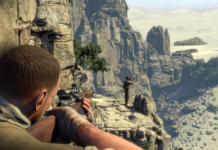Max Payne 3 – Game Analysis & Review
By Patrick Newman
Developer: Rockstar
Publisher: Rockstar Games
Distributor: Take-Two Interactive
Directors: Sergei Kuprejanov (design), Mark Tennant (animation), Rob Nelson (art)
Designers: Jason Bone, John MacPherson, Jonathan Hodge
Writers: Dan Houser, Michael Unsworth, Rupert Humphries
Composer: Health
Engine: RAGE
Platforms: Microsoft Windows, PlayStation 3, Xbox 360
Release Dates: PlayStation 3 & Xbox 360 (May 15, 2012), Microsoft Windows (June 1, 2012)
Genre: Third-person shooter
Modes: Single-player, multiplayer
Rating: Mature
Max Payne, that world-weary potpourri of Phillip Marlowe, John McClane and various Hong Kong-influenced 90’s action movies, has been absent from the gaming scene for nine years, taking an extended leave after 2003’s The Fall of Max Payne. Rockstar’s newest iteration, Max Payne 3, arrives at a time when the popularity of first-person shooters (excepting the military genre) is on the wane. These circumstances give Max Payne 3 plenty to prove to both its cash-cow competitors and its forerunner, which successfully made an impact during a burgeoning era of action gameplay, and practically demands a significant succession.
Max Payne 3 is surprisingly reverent of the series’ form, not re-inventing Max Payne’s bullet-time driven combat system so much as polishing it to a mirror shine. The production values of the game are astonishing, with ultra-smooth animations as Max switches between his rifle and sidearm and covers behind barriers during gunplay (a more modern addition for those gamers nursed on Gears of War). Much like Halo, Max Payne has a more restricted armory for this outing, being allowed to brandish only a single rifle and sidearm, or a sidearm in each hand.
Though the cover-based combat accompanies the introduction of a slew of enemies that are tougher and smarter than any featured in previous Max Payne games, the earlier titles’ philosophy of making Max almost God-like in his shooting prowess remains. Despite the character’s slide into extreme alcoholism and narcotics abuse (a character trait that becomes wearying before the story is even halfway through), Max still possesses a real knack for murdering people.
Powered by the new Euphoria physics animation system, the fluidity and visual detail of Max’s numerous gunfights is unparalleled. Pressing RB sends Max into a John Woo-style slow motion dive (now improved with the ability to continue firing after hitting the ground), and a tap of the Y button sends the entire environment into slow-motion, freeing Max to empty careful rations of bullets into the enemies surrounding him to quickly sweep a room. Though the detailed display of carnage (and all of the shattered glass and splintering wood that goes with it) is a fun diversion, this game, more so than its contemporaries, is simplistic in a way that minimizes its power. Each level, no matter how dressed-up, simply feels like a series of bot-filled corridors and bowls rather than than the dynamic, unpredictable site of a cinematic action scene.
Max Payne 3’s multiplayer, which can be looked to as a test run for what Rockstar will likely bring to their next Grand Theft Auto installment, is strongly reminiscent of Call of Duty’s XP-driven progression system. The vendetta-chasing aspect of team deathmatch can be highly enjoyable, giving players catharsis at last after being repeatedly pulverized by online combat veterans, but the most inspired multiplayer mode is easily Gang Wars. In this mode, actual narrative objectives such as territory capture are assigned to teams, with the winners announced at the end of five rounds.
What all of this adds up to is a game that is very much of a piece with its predecessors, but doesn’t twist or upgrade the genre enough to make it essential. Aside from the improved combat mechanics, which are admittedly gorgeous, Max Payne 3’s single player campaign would be very much at home in 2003. Though the transplanted setting of Sao Paulo, Brazil offers a vibrant contrast to the monochromatic New York of Max Payne and Max Payne 2, the constant, overwritten voice over by series veteran James McCaffrey comes off as more of a ludicrous cliche than welcome throwback. Borrowing its chaotic visual style (and much of its narrative) from Tony Scott’s Man on Fire is another move that seems more derivative than inspired, making Max Payne 3 inexcusably dull through several passages in its 10-hour span.
[hana-flv-player video=”http://videos.punchdrunkgamer.com/videos/Max_Payne_3_Official_Launch_Trailer.flv” width=”550″ height=”430″ description=”Max Payne 3 – Official Launch Trailer” player=”4″ autoload=”true” autoplay=”false” loop=”false” autorewind=”false” /]
Post your comments directly below! You can also discuss the latest MMA & Video Game News in the PunchDrunkGamer Forums and don’t forget to Follow PDG on Twitter @PunchDrunkGamer and Like the PDG Official Facebook Page!











